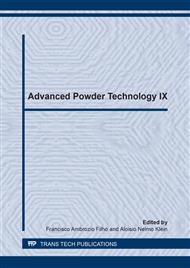p.373
p.377
p.383
p.388
p.392
p.398
p.404
p.409
p.415
Friction and Wear Behavior Evaluation of DLC Films Grown in Multilayer of Carbon and Silicon
Abstract:
Excellent tribological properties of hard materials surface are desirable in several sectors of industry. Diamond-like carbon (DLC) coatings are well known for their low friction, excellent wear resistance, and high hardness. In this work, DLC films were deposited on AISI M2 steel using a modified PECVD pulsed-DC discharge. Multilayer of carbon and silicon were grown, alternately. Samples were produced with different layer thickness for carbon and silicon, and the same parameters for each material layer, in order to investigate friction coefficient in each layer, evaluate rate deposition variation and the gradient behavior of different layers. Raman spectroscopy was used to verify the structural arrangement of carbon atoms. The films were also characterized by scanning electron microscopy and EDX. Tribological tests were performed to observe adhesion between layers and substrate, friction, and wear. The results showed the variation of friction coefficient and that deposition rate declines when increasing number of layers.
Info:
Periodical:
Pages:
392-397
Citation:
Online since:
December 2014
Keywords:
Price:
Сopyright:
© 2014 Trans Tech Publications Ltd. All Rights Reserved
Share:
Citation:


